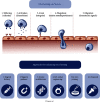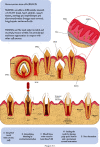Cell-Based Transplantation versus Cell Homing Approaches for Pulp-Dentin Complex Regeneration
- PMID: 34646323
- PMCID: PMC8505125
- DOI: 10.1155/2021/8483668
Cell-Based Transplantation versus Cell Homing Approaches for Pulp-Dentin Complex Regeneration
Abstract
Regenerative dentistry has paved the way for a new era for the replacement of damaged dental tissues. Whether the causative factor is dental caries, trauma, or chemical insult, the loss of the pulp vitality constitutes one of the major health problems worldwide. Two regenerative therapies were introduced for a fully functional pulp-dentin complex regeneration, namely, cell-based (cell transplantation) and cell homing (through revascularization or homing by injection of stem cells in situ or intravenously) therapies, with each demonstrating advantages as well as drawbacks, especially in clinical application. The present review is aimed at elaborating on these two techniques in the treatment of irreversibly inflamed or necrotic pulp, which is aimed at regenerating a fully functional pulp-dentin complex.
Copyright © 2021 Geraldine M. Ahmed et al.
Conflict of interest statement
The authors declare that they have no conflicts of interest.
Figures
Similar articles
-
Dentin-Pulp Tissue Regeneration Approaches in Dentistry: An Overview and Current Trends.Adv Exp Med Biol. 2020;1298:79-103. doi: 10.1007/5584_2020_578. Adv Exp Med Biol. 2020. PMID: 32902726 Review.
-
Dentin and dental pulp regeneration by the patient's endogenous cells.Endod Topics. 2013 Mar;28(1):106-117. doi: 10.1111/etp.12037. Endod Topics. 2013. PMID: 24976816 Free PMC article.
-
[State of the art and perspective of pulp regeneration].Zhonghua Kou Qiang Yi Xue Za Zhi. 2018 Jun 9;53(6):361-366. doi: 10.3760/cma.j.issn.1002-0098.2018.06.001. Zhonghua Kou Qiang Yi Xue Za Zhi. 2018. PMID: 29886628 Review. Chinese.
-
Pulp Regeneration: Current Approaches and Future Challenges.Front Physiol. 2016 Mar 7;7:58. doi: 10.3389/fphys.2016.00058. eCollection 2016. Front Physiol. 2016. PMID: 27014076 Free PMC article. Review.
-
Regenerative Endodontics by Cell Homing.Dent Clin North Am. 2017 Jan;61(1):143-159. doi: 10.1016/j.cden.2016.08.010. Dent Clin North Am. 2017. PMID: 27912815 Review.
Cited by
-
Extracellular Vesicles-Induced Cell Homing and Odontogenesis via microRNA Signaling for Dentin Regeneration.Int J Mol Sci. 2025 Jul 25;26(15):7182. doi: 10.3390/ijms26157182. Int J Mol Sci. 2025. PMID: 40806315 Free PMC article.
-
Applications of piezoelectric biomaterials in dental treatments: A review of recent advancements and future prospects.Mater Today Bio. 2024 Oct 4;29:101288. doi: 10.1016/j.mtbio.2024.101288. eCollection 2024 Dec. Mater Today Bio. 2024. PMID: 40018432 Free PMC article. Review.
-
Regenerative endodontic therapy: From laboratory bench to clinical practice.J Adv Res. 2025 Jun;72:229-263. doi: 10.1016/j.jare.2024.07.001. Epub 2024 Jul 3. J Adv Res. 2025. PMID: 38969092 Free PMC article. Review.
-
Influence of extracellular matrix scaffolds on histological outcomes of regenerative endodontics in experimental animal models: a systematic review.BMC Oral Health. 2024 Apr 30;24(1):511. doi: 10.1186/s12903-024-04266-x. BMC Oral Health. 2024. PMID: 38689279 Free PMC article.
-
Cell-scaffold interactions in tissue engineering for oral and craniofacial reconstruction.Bioact Mater. 2022 Nov 8;23:16-44. doi: 10.1016/j.bioactmat.2022.10.029. eCollection 2023 May. Bioact Mater. 2022. PMID: 36406245 Free PMC article.
References
-
- Shivashankar V. Y., Johns D. A., Maroli R. K., Sekar M., Chandrasekaran R., Karthikeyan S. Comparison of the effect of PRP, PRF and induced bleeding in the revascularization of teeth with necrotic pulp and open apex: a triple blind randomized clinical trial. Journal of Clinical and Diagnostic Research : JCDR . 2017;11(6):Zc34–Zzc9. doi: 10.7860/JCDR/2017/22352.10056. - DOI - PMC - PubMed
Publication types
LinkOut - more resources
Full Text Sources




